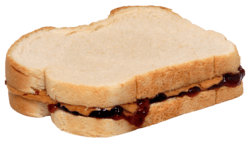Peanut butter and jelly sandwich
|
A peanut butter and jelly sandwich on white bread | |
| Alternative names | PB&J |
|---|---|
| Course | Lunch or snack |
| Place of origin | United States |
| Serving temperature | Room temperature |
| Variations | Peanut butter and jam, other nut butters, with butter or marshmallow fluff |
| 1095 kcal, 18 g fat, 3 g fiber, 59 g carbs[1] kcal | |
|
| |
| Wikibooks Cookbook has a recipe/module on |
A peanut butter and jelly sandwich, or PB&J, includes one or more layers of peanut butter and one or more layers of either jelly or jam on bread. Sometimes the sandwich is eaten open-faced or with one slice of bread folded over (effectively a "half sandwich"). If the peanut butter is not spread on each slice of bread, the sandwich will become soggy if it is left too long to sit.[2][3]
Variations on the sandwich can be created by changing the jelly to honey and instead of peanut butter, someone may use almond butter or another nut butter. Spreads like cream cheese or chocolate spread can be used in place of the peanut butter. When marshmallow fluff is substituted for the jelly, the sandwich becomes a fluffernutter.
A 2002 survey showed the average American will have eaten 1,500 of these sandwiches before high school graduation.[4]
History
Peanut butter was originally paired with a diverse set of foods, such as pimento, nasturtium, cheese, celery, watercress, and toasted crackers.[5] In a Good Housekeeping article published in May 1896, a recipe "urged homemakers to use a meat grinder to make peanut butter and spread the result on bread." The following month, the culinary magazine Table Talk published a "peanut butter sandwich recipe."[6]
The first reference of peanut butter paired with jelly on bread to be published in the United States was by Julia Davis Chandler in 1901 in the Boston Cooking-School Magazine of Culinary Science and Domestic Economics.[7][8] In the early 1900s, this sandwich was adopted down the class structure as the price of peanut butter dropped. It became popular with children by the 1920s as manufacturers began adding sugar to the peanut butter.[9] During World War II, both peanut butter and jelly were found on US soldiers' military ration list.[10]
Nutrition
A peanut butter and jelly sandwich made with white bread, two tablespoons each of peanut butter and strawberry jelly, provides 27% of a person's Recommended Daily Intake of fat and 22% of their calories.[1]
While roughly 50% of the calories are from fat, most of them come from monounsaturated fat and polyunsaturated fats, which have been linked positively with heart health.[11]
.jpg) Sandwich preparation
Sandwich preparation.jpg) Close-up view of a cut peanut butter and jelly sandwich
Close-up view of a cut peanut butter and jelly sandwich
See also
- Fluffernutter
- Fool's Gold Loaf
- Jam sandwich
- Peanut butter, banana and bacon sandwich
- List of sandwiches
- List of peanut dishes
References
- 1 2 "How Nutritious Is a PB&J?". Nutrition.about.com. Retrieved 2012-08-15.
- ↑ Magazine, Bon Appetit Bon Appétit (2013-06-05). "Peanut Butter & Jelly Mistakes You're Making". The Huffington Post. Retrieved 2016-11-13.
- ↑ "How to Make a Peanut Butter and Jelly Sandwich". wikiHow. Retrieved 2017-01-08.
- ↑ "PB&J is A-OK". Prepared Foods 171.10 (): p.32(1). Prepared Foods. Oct 2002.
- ↑ &hl=en&sa=X&ei=etzgT-OhFI-k8QSR9dmcDQ&ved=0CEIQ6AEwAQ#v=onepage&q=Peanut%20butter%20and%20jelly%20sandwich%20Tegin%20Paul%20Mckebzie&f=false Peanuts: The Illustrious History of the Goober Pea Check
|url=value (help). University of Illinois Press. p. 35. - ↑ The Story Behind the Dish: Classic American Foods. ABC-CLIO. p. 166.
- ↑ Chandler, Julia Davis (1901). The Boston Cooking School Magazine of Culinary Science and Domestic Economics.
- ↑ Lau, Maya (June 7, 2013). "Who Made That?". New York Times Magazine.
- ↑ "Food Timeline". Lynne Olver.
- ↑ Why Do Donuts Have Holes?. Citadel Press. p. 127.
- ↑ Corleone, Jill. "ARE PEANUT BUTTER & JELLY SANDWICHES HEALTHY?". Retrieved 31 March 2012.
External links
| Wikimedia Commons has media related to Peanut butter and jelly sandwiches. |
- Fun peanut facts
- Keep your peanut-butter-and-jelly sandwich from getting soggy
- Grilled Peanut Butter and Jelly Sandwich
- History of Peanut Butter & Jelly Sandwich
